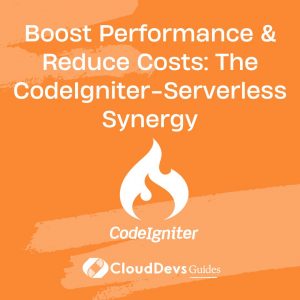Boost Performance & Reduce Costs: The CodeIgniter-Serverless Synergy
In the digital age, the manner in which we host and deploy web applications has experienced a significant transformation. With the emergence of serverless architectures, developers are now equipped with a more flexible, scalable, and cost-effective solution to manage web applications. Particularly for popular PHP frameworks like CodeIgniter, integrating with serverless platforms can elevate the performance and efficiency of your application. In this blog post, we’ll explore the marriage of CodeIgniter with serverless architectures, and why you might want to consider moving beyond traditional hosting.
1. What is Serverless Architecture?
Before diving deep, let’s quickly recap what serverless architecture is. Contrary to the name, serverless doesn’t mean there are no servers involved. Instead, it’s about abstracting away the server management aspect. With serverless, you no longer have to be concerned with server provisioning, scaling, or maintenance. You simply write the code, and the serverless platform automatically manages the infrastructure for you.
Serverless offers:
- Automatic Scaling: It scales automatically with the number of users.
- Pay-as-you-go Model: Only pay for the compute power you use.
- Reduced Complexity: Less worry about server provisioning or maintenance.
2. Why Combine CodeIgniter with Serverless?
CodeIgniter is a powerful PHP framework known for its lightweight nature and performance. Here’s why you might consider pairing it with serverless:
- Performance Boost: Serverless platforms can auto-scale based on demand. For high-traffic CodeIgniter applications, this ensures that resources are always available.
- Cost-Effective: With no idle server time, you only pay for what you use.
- Enhanced Productivity: Developers can focus on writing code rather than managing servers.
3. How to Deploy a CodeIgniter App on a Serverless Platform
For our example, let’s use AWS Lambda, a popular serverless platform, along with the Serverless Framework, which will streamline our deployment process.
3.1. Set Up Your Environment
First, ensure you have:
– AWS CLI set up and configured with appropriate permissions.
– Node.js and Serverless Framework installed.
```bash npm install -g serverless ```
3.2. Create a Serverless Service
Create a new directory for your service and navigate into it:
```bash mkdir ci-serverless && cd ci-serverless ```
Now, create a new Serverless service using the AWS Node.js template:
```bash serverless create --template aws-nodejs ```
3.3. Prepare CodeIgniter for Serverless
Typically, CodeIgniter runs on a LAMP or LEMP stack. For serverless, we’ll use `bref`, a layer that offers PHP support for AWS Lambda.
Install `bref` using Composer:
```bash composer require bref/bref ```
Update the `serverless.yml` file to define your CodeIgniter application’s functions and events. Here’s a simple configuration:
```yml
service: ci-serverless
provider:
name: aws
runtime: provided
plugins:
- ./vendor/bref/bref
functions:
website:
handler: index.php
layers:
- ${bref:layer.php-74-fpm}
events:
- http: 'ANY /'
- http: 'ANY /{proxy+}'
```
This configuration tells Lambda to direct all HTTP requests to our `index.php` file.
4. Deploy the Application
Deploying is now as simple as running:
```bash serverless deploy ```
Once deployed, you’ll receive a URL endpoint for your CodeIgniter application running serverlessly!
5. Handling Database Connections
One challenge with serverless architectures is managing database connections, as traditional persistent connections can quickly exhaust database limits due to the auto-scaling nature of serverless. Solutions include:
– Using connection pooling.
– Using serverless-friendly databases like Amazon Aurora Serverless.
Conclusion
Moving your CodeIgniter application to a serverless architecture can offer performance boosts, reduced costs, and a more streamlined development experience. While it might require some adjustments to your typical workflow and considerations for resources like databases, the benefits of auto-scaling, reduced infrastructure management, and cost savings can be significant.
The combination of CodeIgniter and serverless platforms like AWS Lambda illustrates how the web development landscape is evolving, offering developers more powerful and flexible hosting solutions than ever before. As with any technology decision, assess the specific needs of your project, but don’t shy away from exploring serverless as a viable, modern alternative to traditional hosting.
Table of Contents









